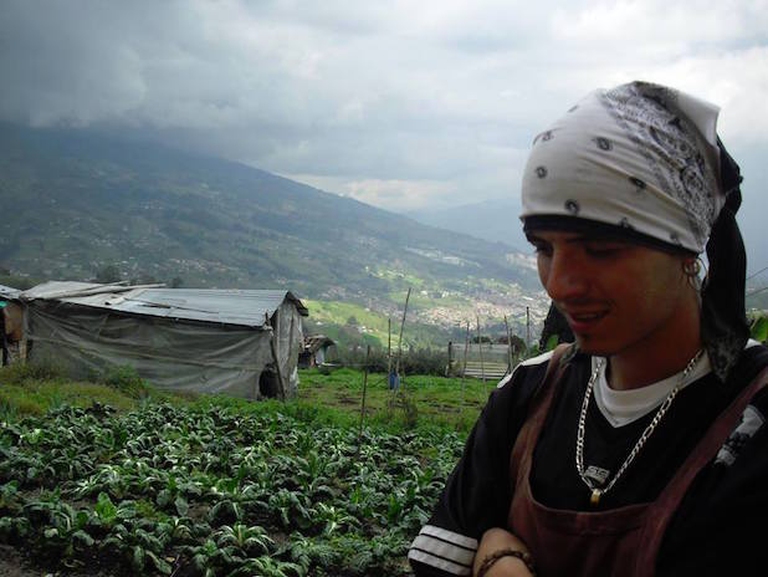
Renzo Piano’s archive in Genoa houses the great architect’s projects. It brings young people closer to creative work, which he equates to “looking into darkness without fear”.
In Medellín, Colombia, Agroarte teaches young people to take back lands wrecked by decades of violence using agriculture and hip hop music.
El Aka is a Colombian rapper who was born and brought up in the Comuna nr. 13, one of the 16 districts of Medellín, a city that became sadly known for being the base for one of the biggest organisations of drug traffickers ever, which operated between the ‘70s and ‘80s.
And that’s not all: just before the beginning of the ’00s decade, the violence and murder rate in the city skyrocketed. In 2002, twenty years after the absence of the Colombian state, 22 military operations were conducted where paramilitaries used total repression: many civilians were mutilated and killed and the “democratic” security strategy involved not declaring the number of deaths. So, the only thing to do was to bury the corpses in the city’s landfills (according to the paramilitaries, over 300 corpses had been buried which have never been exhumed).
In the last years the situation has slowly improved: the government is setting up recovery porgrammes and new cultural and social projects are being spontaneously developed. One of these is Agroarte: a project aimed to fight violence and defend the city that was conceived ten years ago in front of the landfill of the Comuna nr. 13 by El Aka, who wanted to bring people together through hip hop and agriculture.
We’ve started the training process ‘la semilla del futuro’ – the seed of the future – teaching some sixty boys and girls to sing hip hop music songs and to be farmers.
Young people are taught how to seed, work the land and grow gardens in order to take back the lands so far marred by violence. At the same time, boys and girls write and sing hip hop songs using their words to document the events they lived and express their own feelings.
Hip Hop was formed in the Bronx, New York, in an urban area, while our country includes mines and is made of 70% rural areas. Our grandparents and fathers have peasant origins, so if hip hop for us is the street, under the street there’s the land telling our story, memories and struggles.
El Aka
Hip hop wasn’t initially included in the Agroarte project, but young people living in the region expressed their desire to learn to do hip hop. So El Aka decided to teach it to young people, making music a crucial part of the project. An album entitled Custodio del Hip Hop Colombiano – in English “guardian of Colombia’s hip hop” – is produced every year.
Hip hop was one of the most popular music trends in Medellín in the ‘80s, mostly in the city’s poorer districts: it played a fundamental role in promoting popular resistance and creating collective memory.
Seed of the future is demonstrating that culture can create and support communities in areas where violence and social invisibility has flared for about sixty years, transforming them into spaces of growth and memory.
Siamo anche su WhatsApp. Segui il canale ufficiale LifeGate per restare aggiornata, aggiornato sulle ultime notizie e sulle nostre attività.
![]()
Quest'opera è distribuita con Licenza Creative Commons Attribuzione - Non commerciale - Non opere derivate 4.0 Internazionale.
Renzo Piano’s archive in Genoa houses the great architect’s projects. It brings young people closer to creative work, which he equates to “looking into darkness without fear”.
The 50th anniversary of the Moon landing on 20 July has awakened the fantasy of many. Here’s the perfect playlist of musicians who have let themselves be inspired by the universe and its celestial bodies.
N’we Jinan is a Canadian record label that gives First Nations students their voice back by allowing them to create their own music in mobile recording studios.
The Australian songwriter, who became famous with Follow the Sun, is back with Walk Away, a new and powerful ode to freedom. He’s about to set off on a world tour. Our interview with Xavier Rudd.
Three teenagers from New Zealand sing in the Maori language about abuse at the hands of British colonisers. Thanks to their thrash metal music, young people are being attracted to native culture.
There’s no room for anger, resignation, or desire for revenge in this playlist. There’s just the moral obligation of retracing and telling the stories that can’t go lost and forgotten all over again. We do so through music.
Le canzoni più belle del 2017 secondo LifeGate Radio. Con questa playlist lanciamo la nostra collaborazione con Spotify Italia che vi farà ascoltare la musica migliore, selezionata.
An organisation that unites over 1,000 mainly Maya women in Guatemala has expressed alarm that indigenous handicrafts, textiles called “huipiles” in particular, are under threat because underpriced industrial fabrics appropriating indigenous patterns have flooded the Guatemalan market, depriving many native women of their main source of income. Read more: Down to Xjabelle, the fashion collection by a young designer with Down
Rwandan creatives share a common dream: they want to use their art to bring about positive change in society, as well as put their country on the map. They’re mostly young, ambitious, self-taught and have a strong desire and determination to challenge mentalities, move forward and grow. In her documentary RWANDArt: A new creative generation, which








